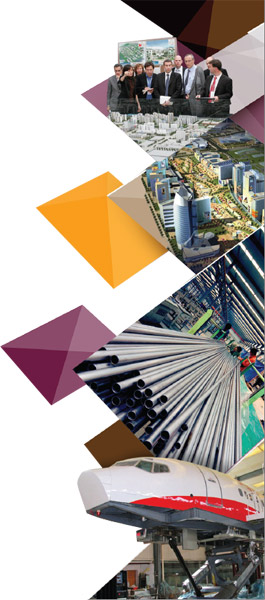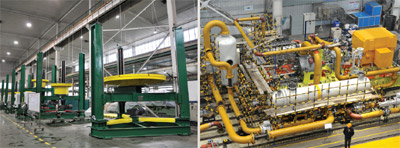 A HUB OF INNOVATION IN WESTERN CHINA A HUB OF INNOVATION IN WESTERN CHINASituated in the heart of the Chinese mainland, Shaanxi is building on its ancient heritage to become a model of modern entrepreneurship In addition to Shaanxi’s famed role as one of the cradles of ancient Chinese civilisation, the province is also full of modern vitality and exhibits profound economic potential. Shaanxi lies in the hinterland of the Chinese mainland and occupies a total area of 205,800 square kilometres. The province is home to 37.7 million people, and its capital city, Xi’an, is the point of departure for the Silk Road, as well as a world-renowned historical and cultural city. As a late-mover in the push to develop economically, Shaanxi has recently made concerted efforts to promote strong growth, leading it to stand out distinctly among the western provinces of China in terms of its continued high level of economic and social development. In 2014, Shaanxi achieved a GDP of US$277.55bn, up 9.7 per cent on 2013, translating to a per-capita GDP of about US$7,650. In terms of both the disposable income of urban residents and the average personal net income of the rural population, Shaanxi’s growth rate has surpassed the national average. The gross economic product of Shaanxi has reached a level 45 per cent higher than that of the five other northwestern provinces, making the province an economic powerhouse that provides strategic support to a new round of regional development in the west.
 Within Shaanxi, infrastructure for air traffic, railroads and highways have all been well established. Xi’an’s Xianyang Int’l Airport is the northwestern region’s air traffic hub, operating 352 local and international flights to 129 mainland cities and 25 foreign destinations. Xi’an is also one of the six national railway hubs and the heart of a “one-day express rail living circle”. In November 2013, the first “Chang’an” international freight train to Kazakhstan began operations, simultaneously writing a new page in the history of the newly reborn Silk Road. By the end of 2015 the total combined length of highways in the province is expected to break the 5,000km mark, a figure which is among the highest for the nation as a whole.   ABUNDANT AND DISTINCTIVE NATURAL RESOURCES ABUNDANT AND DISTINCTIVE NATURAL RESOURCES
Shaanxi is rich in mineral resources, both in quantity and variety. Reserves of 93 distinct minerals have been proven, 55 of which are the largest reserves of their kind in the country. Major natural resources include coal and charcoal, crude oil and natural gas. Proven reserves of coal and charcoal total 167.6 billion tonnes, representing one fourth of the national total. Reserves of crude oil stand at 1.4 billion tonnes, the seventh largest in the country, while reserves of natural gas exceed 1,000 billion cubic metres, the second highest amount in the country. Renowned tourist attractions also abound. Unique scenery includes the breath-taking Huashan and magnificent Hukou Waterfall on the Yellow River. The Qinling mountain range is regarded as a “biological DNA database” and a “museum of Mother Nature”. In addition to its natural riches, Shaanxi has an extremely rich history: 13 dynasties established their capitals there, leaving behind a wealth of historical relics spanning more than a thousand years. Millions of tourists have flocked to Xi’an to see the mausoleum of the first emperor of China, Qin Shi Huang, which is often referred to as the “eighth wonder of the world”. In 2014 Shaanxi welcomed a total of 33 million visitors, 2.66 million of whom were foreign tourists, representing a 16.5 per cent increase from 2013. STRONG INDUSTRY BASE Half a century of investment in Shaanxi has witnessed the growth and flourishing of a relatively complete mix of industries. In addition to Shaanxi’s defense industry, which leads the country in terms of its scale, other flourishing industries include manufacturing of machinery, aeronautics and aerospace, textiles, electronics, pharmaceuticals, energy and food products. The province is also putting its weight behind hi-tech and new technology to foster strengths in advanced industries such as modern agriculture, telecommunications, bio-engineering, space technology, optomechatronic integration, new materials and energy efficiency. A number of world-renowned enterprises such as Micron Technology, Applied Materials, Air Products & Chemicals and Samsung have been attracted by Shaanxi’s favourable investment conditions.  EXCELLENT TECHNICAL EDUCATION EXCELLENT TECHNICAL EDUCATION
Much of Shaanxi’s strength in technology-intensive industries derives from its status as one of the country’s leading providers of technology education. The province now boasts 1,076 research institutes, 11 national-level laboratories, 50 national departmental specified laboratories, and 59 academicians from the Chinese Academy of Sciences and the Academy of Engineering. The province has set up 116 tertiary institutions, which together have recruited 1.33 million students, more than 90,000 researchers, and 1.13 million professional technicians. Thanks to its comprehensive education system, Shaanxi never lacks for technologically skilled labour and possesses a wealth of human capital to draw upon in its future development. ECONOMIC CO-OPERATION
 INVESTMENT ENVIRONMENT INVESTMENT ENVIRONMENT

For more information, please contact: Shaanxi Provincial Department of Commerce Xincheng Da Yuan Xian Shaanxi Province PRC Tel: 86-029-87291591 Fax: 86-029-87291618 Web: www.sxdofcom.gov.cn |


